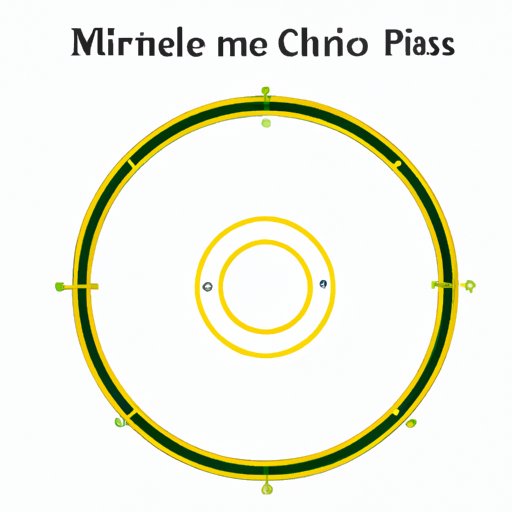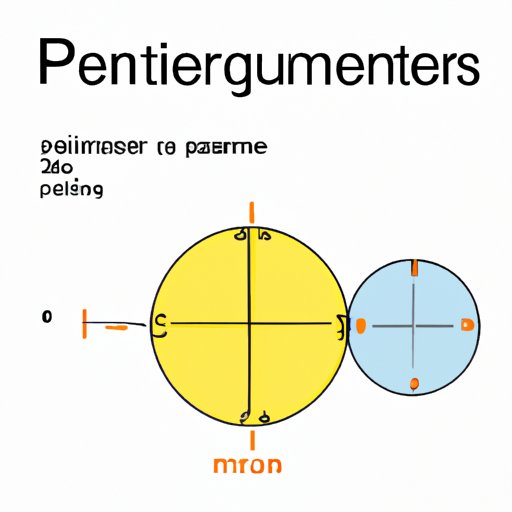Introduction
Have you ever wondered how to find the perimeter of a circle? Calculating the perimeter of a circle can be a challenging task, especially if you are not familiar with the formula and the concept behind it. This article aims to provide a comprehensive guide on how to find the perimeter of a circle, from understanding what a circle is to exploring different methods for calculation. This article is targeted towards students and professionals who deal with circles in their daily lives and want to enhance their problem-solving skills.
Circles 101: Understanding and Calculating Perimeter
A circle is a geometric shape that is defined by a set of points equidistant from a given point, called the center. A circle has several properties, including its diameter, radius, and circumference. The perimeter of a circle, also known as its circumference, is the total distance around its outer boundary.
The perimeter of a circle is a useful measure in many applications, including engineering, architecture, and mathematics. For instance, finding the perimeter of a circle is essential to calculate the length of a wire needed to encircle a circular fence or the distance traveled by a wheel that is driven in circular motion.
Discovering the Formula for Finding the Perimeter of a Circle
The formula for calculating the perimeter of a circle is 2πr, where r is the radius of the circle. Alternatively, the formula can be written as πd, where d is the diameter of the circle. This formula is derived from the definition of a circle and represents the relationship between the perimeter and the radius or diameter.
The formula can be used to calculate the perimeter of a circle in various scenarios. For example, if the radius of a circle is 4 cm, its perimeter would be 2π(4) = 8π cm. Similarly, if the diameter of a circle is 8 cm, its perimeter would be π(8) = 8π cm.
However, while the formula is a helpful tool, it is important to note its limitations. The formula assumes that the shape of the circle is perfect, which may not always be the case in real-world scenarios. Moreover, in some cases, the precision required may necessitate more detailed calculations than the formula.
Step-by-Step Guide on How to Calculate the Perimeter of a Circle
To calculate the perimeter of a circle, follow these steps:
- Measure the radius or diameter of the circle.
- If the radius is given, use the formula 2πr to calculate the perimeter. If the diameter is given, use the formula πd.
- Substitute the value of r or d in the formula and calculate the perimeter using a calculator or manual computation.
For instance, to find the perimeter of a circle with a radius of 5 cm, use the formula 2πr = 2π(5) = 10π cm. Similarly, to find the perimeter of a circle with a diameter of 10 cm, use the formula πd = π(10) = 10π cm.
The Importance of Knowing How to Find the Perimeter of a Circle
The ability to find the perimeter of a circle is crucial for various fields, including science, technology, and finance. In science, knowing how to calculate the perimeter of a circle is essential for analyzing the properties of circular objects, such as planets and cells. Similarly, in technology, understanding the perimeter of a circle can aid in the design and development of circular devices, such as disk drives and turbines. In finance, the perimeter of a circle can be used to calculate interest rates and investment returns based on compounding interest.
Moreover, the knowledge of how to find the perimeter of a circle can enhance problem-solving skills and analytical thinking. By mastering the formula and its applications, individuals can approach complex circular problems with confidence and ease.
Cracking the Perimeter Code: Tips and Tricks for Circle Calculations
To make circle calculations easier and faster, several tips and tricks can be used. For instance, a quick approximation of the perimeter of a circle can be obtained by multiplying the diameter with π. The value of π, which is approximately 3.14, can be used to estimate the perimeter, especially in situations where high accuracy is not required.
Another trick is to use formulas for related shapes, such as rectangles and triangles, to estimate the perimeter of a circle. For example, a circle can be approximated as a polygon with many sides. Dividing the perimeter of the polygon by the number of sides can provide an estimation of the perimeter of the circle.
Exploring the Geometry of Circles: Perimeter Calculation Made Easy
One way to simplify perimeter calculations without using the formula is by utilizing the geometry of circles. Specifically, the properties of inscribed and circumscribed shapes can provide a natural way to compute the perimeter of a circle.
For instance, if a square is circumscribed around a circle, the side length of the square would be equal to the diameter of the circle. Therefore, the perimeter of the circle can be approximated as the perimeter of the square, which can be calculated as 4 times the side length. Similarly, if a regular polygon is inscribed inside a circle, its perimeter can be used to estimate the perimeter of the circle.

Mastering the Art of Finding the Perimeter of a Circle: A Comprehensive Guide
There are several methods for finding the perimeter of a circle, including the formula, tips and tricks, and geometry-based approaches. By mastering these methods, individuals can enhance their problem-solving skills and apply their knowledge to various fields and scenarios.
Some final insights and recommendations for mastering the art of finding the perimeter of a circle include practicing with different examples, using visual aids and diagrams to aid comprehension, and collaborating with peers to exchange ideas and solutions.
Conclusion
In conclusion, finding the perimeter of a circle is an important skill for many fields and applications. By understanding the concept of a circle, the formula for finding its perimeter, and various tips and tricks, individuals can approach circular problems with confidence and ease. Whether you are a student, a professional, or simply interested in circles, mastering the art of finding the perimeter of a circle can enhance your analytical thinking and problem-solving abilities.
